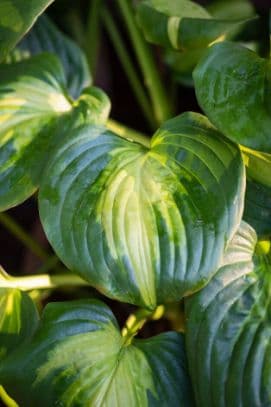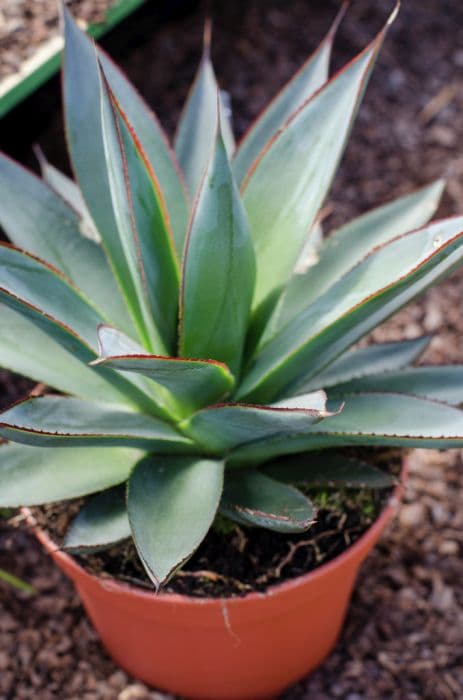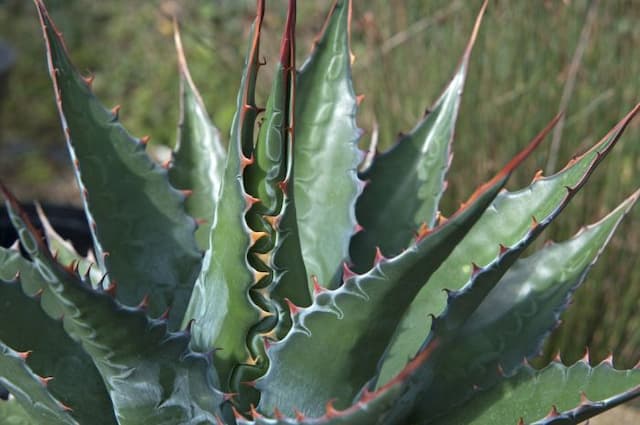Hosta Hosta 'Cathedral Windows' (v)

ABOUT
Cathedral Windows is a variety of hosta that is prized for its striking foliage. These plants are distinguished by their large, heart-shaped leaves that have a distinctive appearance. The leaves themselves are of a rich green color and feature prominent veins. The most captivating aspect of Cathedral Windows' leaves is the bright yellow to cream-colored centers that are bordered by a wide, deep green margin, which creates a stunning contrast. This variation of hosta blooms in the summertime, producing tall flower stalks that extend above the foliage. The flowers are typically bell-shaped and can have a lavendar to pale violet color, adding an additional attractive element to the plant. Overall, Cathedral Windows presents a lush and vibrant look, making it a favorite among garden enthusiasts for its decorative leaves and contrasting colors.
About this plant
 Names
NamesFamily
Asparagaceae
Synonyms
Plantain Lily, Funkia
Common names
Hosta 'Cathedral Windows'.
 Toxicity
ToxicityTo humans
Hostas, in general, are not considered highly toxic to humans. However, if ingested, they may cause mild stomach upset or diarrhea. It is still advisable to keep the plant out of reach of young children who might chew on it.
To pets
Hostas are known to be toxic to pets, especially dogs and cats. If ingested, they can cause vomiting, diarrhea, and depression. It is important to prevent pets from eating any part of the plant, as the consequences can range from mild gastrointestinal upset to more severe symptoms depending on the amount consumed.
 Characteristics
CharacteristicsLife cycle
Perennials
Foliage type
Deciduous
Color of leaves
Variegated
Flower color
White
Height
1 foot 6 inches (46 centimeters)
Spread
2 feet (61 centimeters)
Plant type
Herb
Hardiness zones
3
Native area
Asia
Benefits
 General Benefits
General Benefits- Aesthetic Appeal: Hosta 'Cathedral Windows' has large, heart-shaped leaves with bright, variegated patterns that add visual interest to any garden.
- Shade Tolerance: This plant thrives in shady areas where other plants might struggle, making it ideal for garden spots with less direct sunlight.
- Low Maintenance: Hostas are known for being low-maintenance, requiring minimal care once established.
- Drought Resistance: Once established, Hosta 'Cathedral Windows' can tolerate periods of dryness, making it suitable for gardens with less frequent watering.
- Seasonal Interest: Produces attractive flowers in the summer, and the foliage often changes color in the fall, extending interest throughout the growing season.
- Border and Groundcover Use: The dense foliage makes it a great option for borders and groundcover, suppressing weeds and reducing soil erosion.
- Winter Hardiness: It is winter hardy in many climates, dying back in the winter and returning in the spring ready for another year's growth.
- Companion Plant: Complements other shade-loving perennials and can be used effectively in mixed beds and borders for contrast and variety.
- Pest Resistance: Hostas are resistant to many pests, though slugs can be an issue, making them relatively trouble-free plants for gardeners.
 Medical Properties
Medical PropertiesThis plant is not used for medical purposes.
 Air-purifying Qualities
Air-purifying QualitiesThis plant is not specifically known for air purifying qualities.
 Other Uses
Other Uses- Edging or Border Accent: Hostas can create a lush, leafy edge along walkways or garden borders, providing a textural contrast to other plants and hardscaping materials.
- Shade Garden Focal Point: Due to its striking foliage, Hosta 'Cathedral Windows' can serve as a centerpiece in shady garden areas, drawing attention with its variegated leaves.
- Container Gardening: Hostas can thrive in pots or containers, allowing those with limited space or poor soil to enjoy their beauty on patios, balconies, or decks.
- Ground Cover: These plants can be used to fill in large, shady areas where grass might struggle, creating a lush, green carpet effect with minimal maintenance.
- Water Garden Companion: Hostas can be planted near ponds or water features to complement the aquatic environment with their luxurious leaves.
- Crafts and Flower Arranging: The large and attractive leaves of Hostas can be used in floral arrangements or crafts, adding a unique texture and shape.
- Photography: Garden photographers often use Hostas as subjects to capture the intricate patterns and dew on their leaves in the morning light.
- Culinary Use: Young Hosta shoots are edible and can be used in a similar fashion to asparagus, although this is not a conventional use in Western cuisine.
- Erosion Control: Planting Hostas on slopes or banks can help prevent soil erosion thanks to their dense root systems.
- Habitat Support: Hostas can provide shelter for small ground-dwelling creatures such as frogs, toads, and beneficial insects.
Interesting Facts
 Feng Shui
Feng ShuiThe Hosta is not used in Feng Shui practice.
 Zodiac Sign Compitability
Zodiac Sign CompitabilityThe Hosta is not used in astrology practice.
 Plant Symbolism
Plant Symbolism- Devotion and Prayer: The name 'Cathedral Windows' suggests a connection to the quiet contemplation and reverence found within a cathedral, symbolizing an environment conducive to prayer or devotion.
- Refuge and Sanctuary: Hostas are known to thrive in shade, indicating a symbol of protection, like the sheltering nature of a sanctuary.
- Beauty in Solitude: The lush foliage and attractive patterns of the Hosta can signify the beauty that exists in solitary places, or in the aspects of life that are not in the spotlight.
- Resilience and Adaptability: Hostas are hardy and adaptable to various growing conditions, symbolizing the ability to endure and thrive in changing circumstances.
 Water
WaterTo properly water Hosta 'Cathedral Windows', commonly known as hostas, check that the top inch of soil is dry before watering. They prefer consistently moist soil, so during the growing season, watering once or twice a week may be necessary, depending on climate conditions and rainfall. Apply water directly to the base of the plant to avoid wetting the leaves, which can invite disease. Hostas generally need about 1 gallon of water per week, ensuring that the moisture reaches the root zone. During hot, dry spells, they may require more frequent watering, while established hostas in cooler, shaded environments may need less.
 Light
LightHostas thrive best in partial to full shade, making Hosta 'Cathedral Windows' ideal for spots with dappled sunlight or areas that receive morning light but are shaded from the harsh afternoon sun. Avoid placing them in direct, strong sunlight as it can scorch their leaves. The best lighting condition for these plants is a location that mimics the light conditions of their natural woodland habitats.
 Temperature
TemperatureHosta 'Cathedral Windows' grow well in a wide range of temperatures typical of their hardiness zones. They can survive in temperatures as low as 30°F but are dormant below this threshold. The ideal growth conditions are between 50°F and 80°F. Avoid exposing hostas to temperatures above 90°F, as extreme heat can stress the plant.
 Pruning
PruningHosta 'Cathedral Windows' should be pruned to remove dead or damaged foliage, which can be done at any time during the growing season. Additionally, tidy up the plant by removing spent flower stalks and yellowing leaves. The best time for a thorough pruning is late fall or early winter, after the plant has gone dormant; this helps prevent disease and pest issues. Generally, hostas require little pruning other than this basic maintenance.
 Cleaning
CleaningAs needed
 Soil
SoilHostas prefer a well-draining, rich, and loamy soil blend. For "Cathedral Windows" a good mix could include equal parts of garden soil, peat moss, and perlite or pine bark fines to ensure proper drainage and aeration. The ideal soil pH should range between 6.0 and 7.5 to facilitate nutrient uptake for healthy growth.
 Repotting
Repotting"Cathedral Windows" Hostas generally should be repotted every two to three years or when they outgrow their current container. This is best done in the spring before active growth starts or in the early fall once the plant starts to go dormant.
 Humidity & Misting
Humidity & MistingHostas, including "Cathedral Windows," prefer average to high humidity levels but are typically adaptable to a wide range of humidity conditions commonly found outdoors. They thrive with morning dew and the natural humidity in the air.
 Suitable locations
Suitable locationsIndoor
Place in bright, indirect light and keep soil consistently moist.
Outdoor
Partial shade with moist, well-draining soil is ideal.
Hardiness zone
3-9 USDA
 Life cycle
Life cycleHosta 'Cathedral Windows' begins its life cycle when a seed germinates in moist, well-draining soil, usually in spring. The seedling quickly develops into a young plant with a basic root system and a few leaves. As the plant matures, it forms an increasingly large clump of foliage with characteristic large, heart-shaped, and variegated leaves. Throughout the summer, it produces tall flower stalks that bear bell-shaped, fragrant, white flowers, which can attract pollinators. After flowering, seeds may be produced if pollination occurs, and the plant then gradually enters dormancy as temperatures drop in fall, with its foliage dying back with the first frosts. In winter, the plant remains dormant underground, storing energy in its rhizomes until the next spring when the cycle starts anew with fresh growth emerging once temperatures rise.
 Propogation
PropogationPropogation time
Early Spring to Summer
Hosta 'Cathedral Windows' is typically propagated by division, which is best performed in the early spring or in the fall after the plant has finished blooming and starts to go dormant. To propagate by division, carefully dig up the entire plant, shaking off loose soil to reveal the root structure. Plant clumps should then be separated into smaller sections, ensuring that each new section has at least two or three shoots and a healthy portion of roots attached. These divisions can then be replanted at the same soil depth they were previously growing at, spaced about 12 inches (about 30 cm) apart to give each new plant enough room to grow. Water the new divisions thoroughly to help establish them. This method is popular due to its simplicity and effectiveness in producing new plants that are genetically identical to the parent plant.









